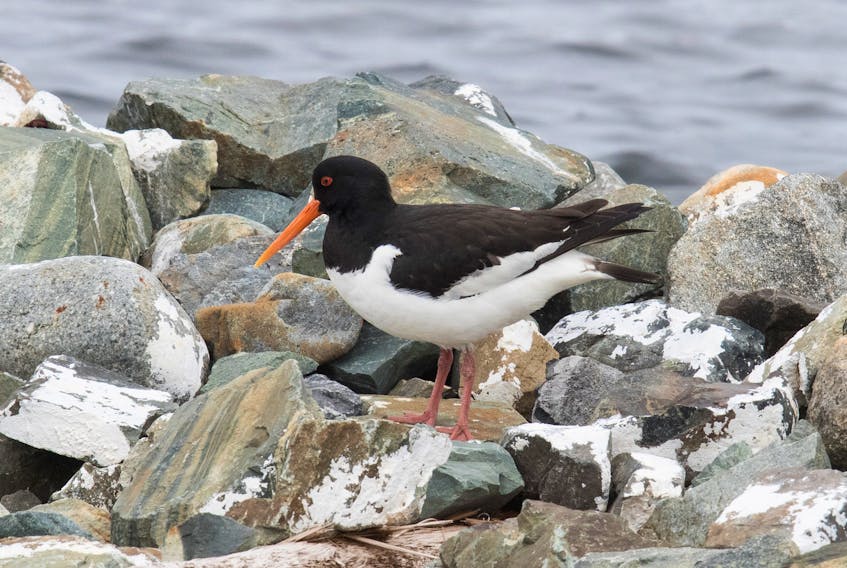
Regular contributor to the Winging It birding line (see the email address at bottom of this column) Bruce Bradbury dropped a bombshell in a brief message. It said an American oystercatcher was seen at Lushes Bight by his sister in law Marilyn Gillingham.
I had to read the email a couple of times before it registered.
First of all I knew the odds of it being an American oystercatcher was remote compared to the similar looking Eurasian oystercatcher. We had already seen a few European vagrant birds this May because persistent northeast winds blowing from Iceland.
A Eurasian oystercatcher is a huge rarity on the North American scale of rare birds. There were just four North American records.
Three were from Newfoundland and one was from Alaska.
The similar looking American oystercatcher occurs on the Atlantic coast of North America just reaching the southern tip of Nova Scotia.
Word of an oystercatcher spread instantly through the birding community that evening. Both Frank King and Shawn Fitzpatrick decided to act immediately and were gone from St John’s well before daylight making the six hour drive to Pelly’s Island in time to catch a morning run on the ferry to Long Island. After the 10 minutes ferry ride followed by a quick drive to Lushes Bight and with help from Marilyn they located the oystercatcher. Meanwhile, local resident Barbara Colbourne sent good pictures of the bird. It was a confirmed Eurasian oystercatcher. It differs from the American oystercatcher in having a blacker head and back, more white in the wing and a white lower back.
Over the next few days including the long weekend a good many birders made the journey to Lushes Bight.
Everyone was successful and left Lushes Bight happy and content with their experience with a new bird. The stocky shorebird is very successful in Europe because of its ability to feed in various types of coastal terrain. I am not sure if it can actually open up an oyster as its name implies but it can make short work of a blue mussel with that red chisel bill. It is also good at lifting up the kelp at low tide looking for any marine critter hiding there. They probe into the mud looking for the biggest ugly marine worms available.
A Eurasian oystercatcher should have no problem feeding itself in Newfoundland. However, Newfoundland is not where it wants to be. Most likely this bird was in migration from wintering grounds in Ireland to nesting territory in Iceland.
Being a strong flier this one probably missed its mark in Iceland and then rode the northeast winds the rest of the way across the Atlantic Ocean and got to Newfoundland before it ran out of body fuel.
It will need to refuel here for a few days at least before trying to correct its navigational error and head back toward Iceland. There is still lots of time for it to get back to Iceland in time to partake in the nesting season.
Meanwhile, birders will continue to travel to Lushes Bight. Personally I had heard of Lushes Bight but did not really know where on the northeast coast it was. Now we do. It has a bright and prominent place on the birders map of Newfoundland.
The cool overcast spring has really slowed down the arrival of spring birds from the south but the silver lining for the birdwatchers is that northeast winds have brought us a few European goodies.
Again, like the oystercatcher, species that were likely migrating from Irish wintering grounds to Iceland summer time nesting grounds but were diverted our way by the winds.
A black-tailed godwit is a spectacular looking shorebird with long legs and an equally long bill. In spring it is decked out in orange with various black and gray bars and spots. One had been enjoyed by many birders feeding in a manure enhanced brook for over a week in early May in the Goulds on the Avalon Peninsula. Even more spectacular was the black-tailed godwit that showed up in the very centre of the island of Newfoundland at Buchans. Gary and Linda Hefford found it probing grass for earthworms by the Boys and Girl Club.
While several people submitted photographs of the bird showing its elegant details none came close to the quality of that of nine-year-old Claire. She sat for 1.5 hours while the bird got used to her presence and walked very close to her as she secured some very fine images with the camera.
A single European golden plover was present in a farm field in Goulds for a one short hour just before the start of the long weekend.
More interesting Icelandic vagrants could occur before May is up according to the wretched weather forecast of rain, drizzle, fog and even wet snow made horizontal by the far reaching northeast winds.
The birders have their fingers crossed.
Bruce Mactavish is an environmental consultant and avid birdwatcher. He can be reached at [email protected]
RELATED:









